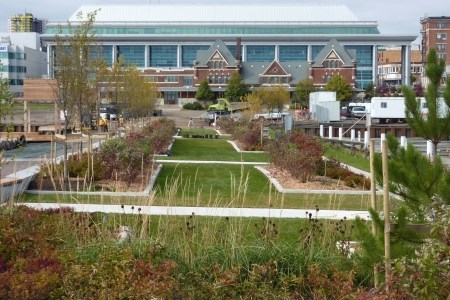A place to live, work and play. That’s what Thunder Bay’s city council and administration are planning to create through the redevelopment of the city’s waterfront.
The project encompasses an area in Thunder Bay’s north end, called Prince Arthur’s Landing, which sits on the shore of Lake Superior. With a mixture of public and private investment, project proponents are working to make the waterfront area a year-round destination for residents and visitors. The vision includes expanding public park areas and recreation activities with the hope of reconnecting the downtown to its waterfront through the construction of a “mixed-use village.”
“What I like about this project is that we will create a waterfront where there’s a strong identity,” said the City of Thunder Bay’s waterfront development manager Katherine Dugmore.
“It will be a fabulous place for citizens and visitors to go.”
City officials hope the project, which involves about $65 million in private funding, will be a catalyst for tourism and help revitalize the north end’s downtown core. The city has sunk $22 million into the waterfront as its share of $66 million in combined government funding.
The publicly funded part of the project includes an arts centre, an exhibit space called Mariner’s Hall, a water garden pavilion, children’s pavilion, skating rink, splash pad, skateboard park, restaurants and cafes. Recreational paths and spaces are also to be added, while featuring public art installations in several locations. Construction work on some of these elements is expected to be complete by April.
There has been some opposition to the re-development due to concerns about the skateboard park, and about how the project would affect existing residential housing nearby.
“Some people were anxious about the (marina) park being taken away,” said Dugmore. “Good urban planning should have parks mixed with residential.”
A major part of the redevelopment includes private investment for a proposed hotel and two condominium buildings. In June, city officials met with the private development consortium, which includes Winnipeg companies Laureate Developments and the Re Solve Group to discuss this part of the development.
Three hoteliers have expressed interest.
The privately funded portion also consists of a commercial building for shops and restaurants, and redevelopment of an historic Canadian National Railway passenger station.
The project is creating about 300 construction jobs per year but is expected to create more permanent jobs through the hotel and marketplace.
Dugmore says infrastructure improvements and job creation were big reasons for attracting Prime Minister Stephen Harper to tour the site in person last September.
Beginning in September 2009, the first stage of the project is nearing completion with infrastructure improvements, new docks, landscaping, a sanitary lift station and a Spirit Garden.
The former Pier 2 has been redesigned and features a tree-lined promenade, dockside picnic areas, and a viewing circle, which is a raised landscaped disc which will be etched with poetry and prose.
“It’s a grass oasis,” Dugmore explained. “There’s a sense of arrival there.”
An early 1900’s Baggage Building, home to the Lakehead Visual Arts Gallery, is to be renovated and expanded with artists studios, as well as exhibition and retail space.
“It’s a very complex project,” said Peter Belluz, president of Manshield Construction, who’s coordinating 15 major contractors and sub-contractors. “It’s going well. Everyone has their area of expertise.”
The condo designs are being finalized with city staff and an announcement of the hotelier is expected in late December.
The groundbreaking for both developments begins in the spring, and work will take two years to complete.
This winter, construction continues with crews focusing on building the water garden pavilion area and the Baggage Building.
“We hope to have the bulk of the site preparation completed before winter,” said Belluz. One of the goals is to have the development complement area businesses by attracting more residents and tourists to the downtown core.
“I think that people living, working and playing in this area will have all the benefits of downtown,” said Dugmore. “We hope to get people exploring the area when they stay at the hotel.”
The city will earn $1 million annually from taxes and lease revenues from tenants renting the refurbished CN Station.
The next phase of work involves an expanded marina and service buildings, with the final phase of the project moving to the former Pool 6 grain elevator lands, which still require environmental assessment approvals.




